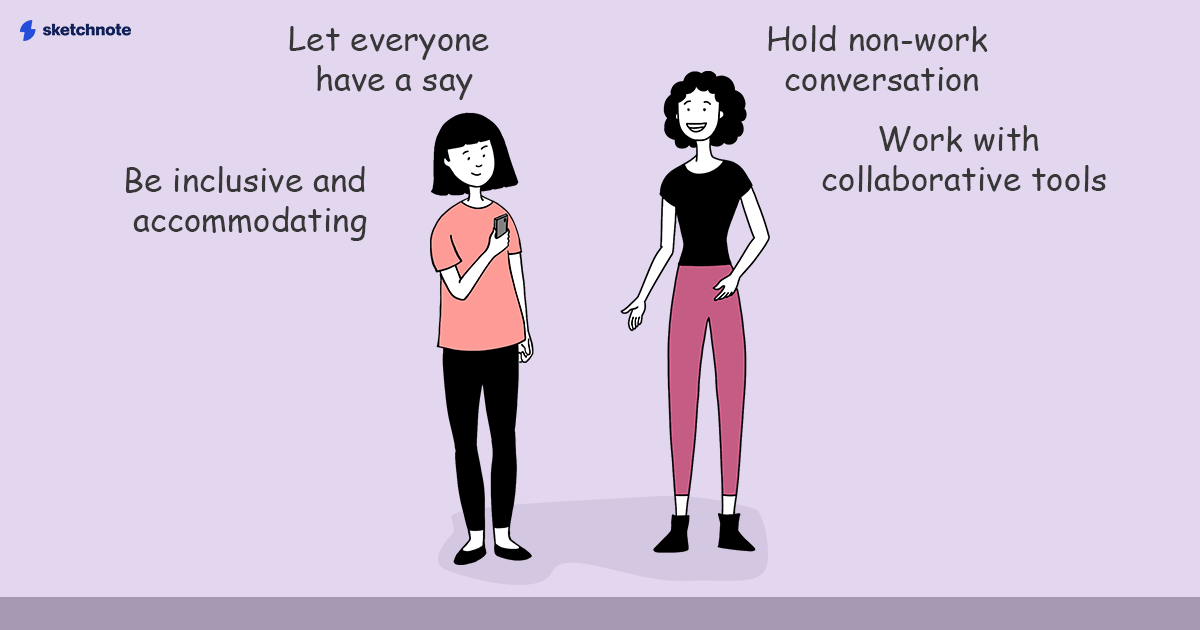It can be very easy for remote employees to feel a sense of alienation from their team at large. Distance tends to make itself felt, especially when the day-to-day routine involves predominantly talking to your colleagues through a screen and collaborating with a fragmented team over chat and productivity apps.
While building a diverse and inclusive team is the future, it's rather hard when the team is rarely in the same room.
This brings up a very solid concern—how to build inclusion amongst remote teammates? Inclusion at work refers to a sense of belongingness to the team and it's a vital part of work life.
In fact, a McKinsey research found that 39 per cent of all respondents say they have turned down or decided not to pursue a job because of a perceived lack of inclusion at an organization. It's hardly surprising that inclusivity is an important factor to choose where one works. After all, one can easily spend 50-odd hours a week with this set of people they're in the same company as, and feeling a sense of belonging is important.
As showrunners, building an inclusive organization helps to acquire and retain quality talent. A major factor that drives good work decisions is how diverse the thought process of the decision-makers are. A harmonious work environment can be fostered only when inclusion is a top priority!
Here are some strategies and best practices for building an inclusive organization—remotely!

Top strategies to build inclusive teams when you’re remote
Listen more
You cannot include people you cannot hear -Aduke Onafowokan
Oftentimes, due to the stress of getting work done, leaders tend to have short, agenda-specific conversations over their shared chat channels. The teammates may find it appropriate to follow the chain of command and may lean towards simply agreeing with the leader.
This also means refraining from challenging the leader's ideas, something which is the antithesis of an inclusive culture. In fact, this blind agreement can deter healthy criticism and lead to disastrous decisions at times. Further, the skills and talents of the subordinates are not being utilized to their full potential, in this process.
The importance of listening cannot be overstated. But in a remote work environment, the opportunity for conversations has to be created first. This has to be followed ensuring that your teammates feel supported when they share their ideas and not dismissed to judged.
Once we have the team ‘talking’, it becomes uber-critical for the leader to listen. The task of building an inclusive team begins with listening. It's important to listen to your colleagues to genuinely understand their unique perspectives, and not merely to respond.
Suspend judgement
‘Judgement’ is a powerful tool while drawing up business plans, budgets and prospective sales. But judging your teammates? Not so much!
In our social lives, we tend to surround ourselves with people who resonate with our thoughts, experiences, and worldview. Our community of like-minded people make us feel that we belong, and it further shapes our worldview. This is positive and healthy, but it can become problematic if we dismiss every other perspective that does not match with those of our community; especially so if this attitude bleeds into our work lives.
Assuming that our point of view is the only correct one, and judging any other as ‘less than,' is a trap we need to be wary of. Judgement can come in the way of understanding and supporting our teammates in the ways that they deserve. Fear of judgement can inhibit teammates to share their ideas for the company. It's a lose-lose situation for everyone involved and needs to be avoided at all costs.
Embrace diversity
It is such a delight to be around and work with people who demonstrate allyship to diverse groups—in word and in spirit. By extending our support to people who are ‘different’ from our specific demographic, we allow our teammates to actually be themselves at work. More diverse thoughts lead to better decision-making.
Upholding inclusion at work cannot be thought of as a ‘work-related’ task, it's a ‘life’ task! Being accepting requires us to challenge internalized biases about ourselves and others. This can happen easily by actively engaging with people who are different from us.
Social media is a great tool to connect with people who are not the same as us. As we begin to see humanity amidst our diversity, we will naturally be more inclusive in life and at work. And that's why this is a life task!

Some best practices for building an inclusive remote team
Let everyone have a say
Running exemplary internal communication is the doorway to overall inclusion. Ensuring that all your employees are communicated equitably and in a respectful manner is step one to inclusion.
A major component of a remote worker's day goes by in virtual meetings. Work meetings are notorious for having one enthusiastic speaker ‘taking-over’ the conversation while the rest of the participants engage passively. This is a massive communication barrier, and more so for remote workers.
Having a shuffling meeting moderator gets all the participants to be more engaged. Further, giving everyone a chance to speak allows employees to feel involved in the conversation, and feel valued.
Even beyond work-related matters, making them part of quick team polls—for themes for happy hours on Fridays, or deciding on the next location for a team meet up—can make your teammates feel heard and included.
Creating room for non-work conversations
Water cooler conversations are an important part of on-site work culture. It's where work friendships begin and lasting acquaintances made. However, starting casual exchanges may seem almost impossible in a virtual work environment.
So, how does one go about the important task of creating opportunities for these casual 1:1 exchanges of ideas. After all, these can make teammates help each other and feel a greater sense of belonging.
Creating channels to discuss popular topics that are doing the rounds on social media, or even share some office humor, can create bonhomie within the team.
Start a virtual graffiti whiteboard for your team to casually leave messages for each other—not only is the scribbling therapeutic, it can also lighten up the environment and foster conversations between teammates who'd otherwise never have the chance to cross paths.
A top-down approach to inclusion
While drafting policies for equity and inclusion are critical, these need to be implemented from the top down. Treating all teammates devoid of any biases creates an environment for fairness. It sets an expectation for acceptable behavior at work, that everyone then emulates.
This also means this is a non-negotiable code of conduct. The only way you can ensure inclusion becomes a way of life for your team is to make sure it's understood well. Conduct sensitization workshops to help your team grasp why inclusion is such a vital part of work life today and for the success of your team.
Accommodate working parents
Any parent will attest to the fact that parenting is a full-time job. In all probability, your teammates with children are constantly juggling between their work tasks and parenting duties, even after office hours.
It is important to be accommodating of their hectic schedule while setting up collaboration sessions or assigning. Being mindful of their school pick up and drop times, or other activities that need their time, can go a very long way.
Speak to your colleagues and figure out when is it that they may need to take a break to tend to their families and try as much as possible to avoid scheduling important calls and meetings at those times.
Collaborative decision-making tools
Decision-making is a complex task that usually requires input from various team members. Using tools, like Sketchnote, that makes this collaboration easy can help them a great deal to feel a part of the process.
Simply using Sketchnote's SCAMPER technique on a virtual whiteboard to make it easy for everyone to participate. Using a Kanban board for a group task lets everyone know who is taking up what part of the project. It also ensures that work is distributed equally amongst the team so no one feels unfairly over-worked. While you can't suddenly make geographical distances disappear, you can do your best to help your scattered team feel connected.
Lastly, the over-arching concept of these strategies and best practices is to be empathetic to your teammates. And empathy could mean different things in different situations. At times, it could mean leaning in while your colleague shares a personal story. Or being mindful of their routine. It could also mean standing up for your teammate—all of these go a long way in helping inclusivity flourish in the workplace.



